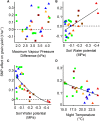Genome-Wide Analysis of Yield in Europe: Allelic Effects Vary with Drought and Heat Scenarios
- PMID: 27436830
- PMCID: PMC5047082
- DOI: 10.1104/pp.16.00621
Genome-Wide Analysis of Yield in Europe: Allelic Effects Vary with Drought and Heat Scenarios
Abstract
Assessing the genetic variability of plant performance under heat and drought scenarios can contribute to reduce the negative effects of climate change. We propose here an approach that consisted of (1) clustering time courses of environmental variables simulated by a crop model in current (35 years × 55 sites) and future conditions into six scenarios of temperature and water deficit as experienced by maize (Zea mays L.) plants; (2) performing 29 field experiments in contrasting conditions across Europe with 244 maize hybrids; (3) assigning individual experiments to scenarios based on environmental conditions as measured in each field experiment; frequencies of temperature scenarios in our experiments corresponded to future heat scenarios (+5°C); (4) analyzing the genetic variation of plant performance for each environmental scenario. Forty-eight quantitative trait loci (QTLs) of yield were identified by association genetics using a multi-environment multi-locus model. Eight and twelve QTLs were associated to tolerances to heat and drought stresses because they were specific to hot and dry scenarios, respectively, with low or even negative allelic effects in favorable scenarios. Twenty-four QTLs improved yield in favorable conditions but showed nonsignificant effects under stress; they were therefore associated with higher sensitivity. Our approach showed a pattern of QTL effects expressed as functions of environmental variables and scenarios, allowing us to suggest hypotheses for mechanisms and candidate genes underlying each QTL. It can be used for assessing the performance of genotypes and the contribution of genomic regions under current and future stress situations and to accelerate breeding for drought-prone environments.
© 2016 American Society of Plant Biologists. All Rights Reserved.
Figures







Similar articles
-
Drought stress and tropical maize: QTL-by-environment interactions and stability of QTLs across environments for yield components and secondary traits.Theor Appl Genet. 2009 Sep;119(5):913-30. doi: 10.1007/s00122-009-1099-x. Epub 2009 Jul 12. Theor Appl Genet. 2009. PMID: 19597726
-
Mapping QTLs associated with agronomic and physiological traits under terminal drought and heat stress conditions in wheat (Triticum aestivum L.).Genome. 2017 Jan;60(1):26-45. doi: 10.1139/gen-2016-0017. Epub 2016 Sep 15. Genome. 2017. PMID: 27996306
-
Characterizing drought stress and trait influence on maize yield under current and future conditions.Glob Chang Biol. 2014 Mar;20(3):867-78. doi: 10.1111/gcb.12381. Epub 2014 Jan 20. Glob Chang Biol. 2014. PMID: 24038882
-
Enhancing drought tolerance in C(4) crops.J Exp Bot. 2011 May;62(9):3135-53. doi: 10.1093/jxb/err105. Epub 2011 Apr 21. J Exp Bot. 2011. PMID: 21511912 Review.
-
Can current crop models be used in the phenotyping era for predicting the genetic variability of yield of plants subjected to drought or high temperature?J Exp Bot. 2014 Nov;65(21):6179-89. doi: 10.1093/jxb/eru223. Epub 2014 Jun 19. J Exp Bot. 2014. PMID: 24948682 Review.
Cited by
-
Can Metabolite- and Transcript-Based Selection for Drought Tolerance in Solanum tuberosum Replace Selection on Yield in Arid Environments?Front Plant Sci. 2020 Jul 21;11:1071. doi: 10.3389/fpls.2020.01071. eCollection 2020. Front Plant Sci. 2020. PMID: 32793257 Free PMC article.
-
The Use of DArTseq Technology to Identify Markers Related to the Heterosis Effects in Selected Traits in Maize.Curr Issues Mol Biol. 2023 Mar 23;45(4):2644-2660. doi: 10.3390/cimb45040173. Curr Issues Mol Biol. 2023. PMID: 37185697 Free PMC article.
-
Penalized factorial regression as a flexible and computationally attractive reaction norm model for prediction in the presence of GxE.Theor Appl Genet. 2025 Mar 28;138(4):88. doi: 10.1007/s00122-025-04865-4. Theor Appl Genet. 2025. PMID: 40155554 Free PMC article.
-
VegAnn, Vegetation Annotation of multi-crop RGB images acquired under diverse conditions for segmentation.Sci Data. 2023 May 19;10(1):302. doi: 10.1038/s41597-023-02098-y. Sci Data. 2023. PMID: 37208401 Free PMC article.
-
Individual plant genetics reveal the control of local adaptation in European maize landraces.BMC Biol. 2025 May 21;23(1):138. doi: 10.1186/s12915-025-02241-8. BMC Biol. 2025. PMID: 40399895 Free PMC article.
References
-
- Allen RG, Pereira LS, Raes D, Smith M (1998) Crop evapotranspiration: guidelines for computing crop water requirements. Food and Agriculture Organization of the United Nations, Rome
-
- Basu D, Tian L, Debrosse T, Poirier E, Emch K, Herock H, Travers A, Showalter AM (2016) Glycosylation of a Fasciclin-Like Arabinogalactan-Protein (SOS5) Mediates Root Growth and Seed Mucilage Adherence via a Cell Wall Receptor-Like Kinase (FEI1/FEI2) Pathway in Arabidopsis. PLoS One 11: e0145092. - PMC - PubMed
-
- Bishop KA, Betzelberger AM, Long SP, Ainsworth EA (2015) Is there potential to adapt soybean (Glycine max Merr.) to future [CO2]? An analysis of the yield response of 18 genotypes in free-air CO2 enrichment: Variation in soybean response to elevated. CO2. Plant Cell Environ 38: 1765–1774 - PubMed
-
- Boer MP, Wright D, Feng L, Podlich DW, Luo L, Cooper M, van Eeuwijk FA (2007) A mixed-model quantitative trait loci (QTL) analysis for multiple-environment trial data using environmental covariables for QTL-by-environment interactions, with an example in maize. Genetics 177: 1801–1813 - PMC - PubMed
-
- Bonneau J, Taylor J, Parent B, Bennett D, Reynolds M, Feuillet C, Langridge P, Mather D (2013) Multi-environment analysis and improved mapping of a yield-related QTL on chromosome 3B of wheat. Theor Appl Genet 126: 747–761 - PubMed
Publication types
MeSH terms
LinkOut - more resources
Full Text Sources
Other Literature Sources

